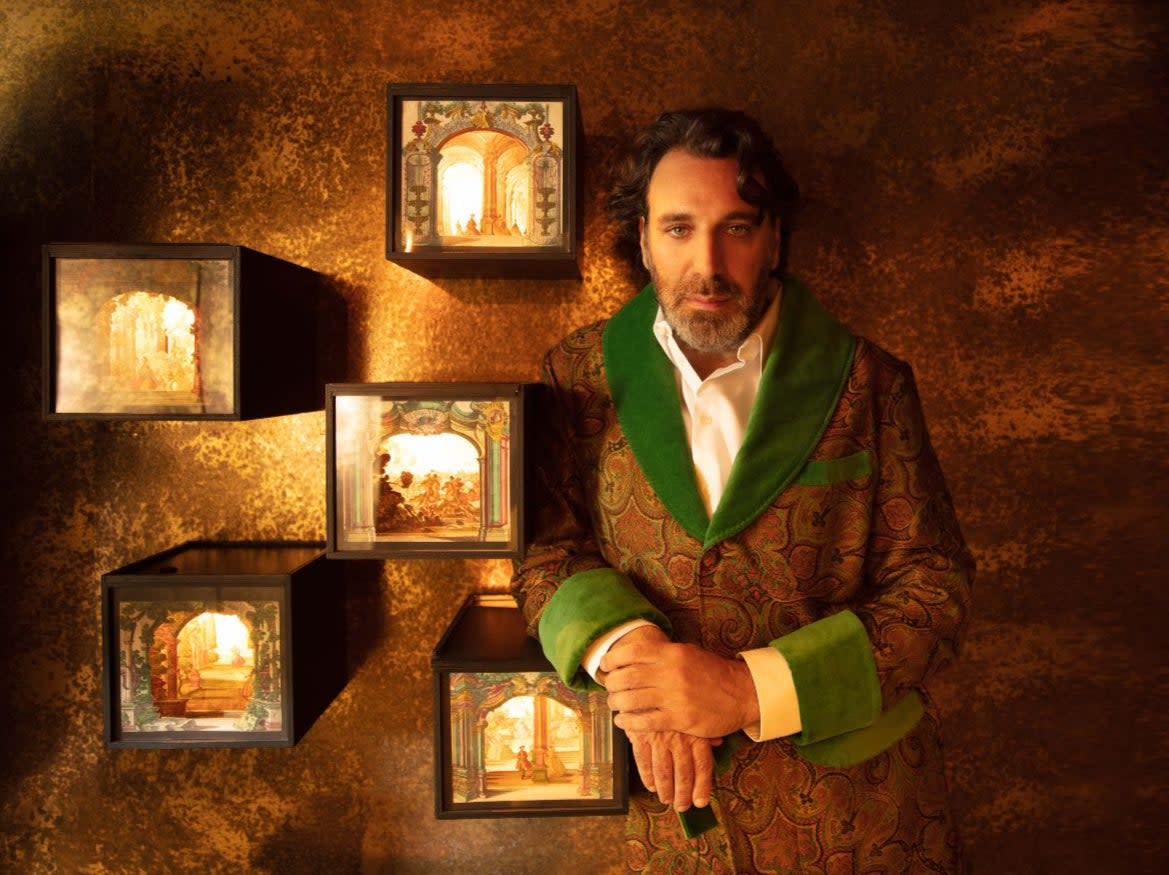It’s the least wonderful time of the year: The sad indie albums saving Christmas

Christmas has always been complicated for Chilly Gonzales. “I feel a bit oppressed by it,” the pianist and producer says. “The forced smile, the entire capitalist dream that we’re being sold.”
His unease with the season of good cheer extends to festive music. Jolly seasonal songs don’t really work for this Montreal-born son of Ashkenazi Jews who fled Hungary during the Second World War. In fact, they strike him as slightly dishonest.
“Christmas songs shouldn’t only be this performative optimism,” he says. “They should contain a grain of melancholy. Especially in 2020, it’s tone deaf to say, ‘Oh Christmas is all going to be ‘happy happy’. I try to live in the real world.”
He isn’t the only artist to acknowledge and celebrate the wistful side of Christmas. A Very Chilly Christmas belongs to a distinct and rather new category of Yuletide music. What might be described as the “indie Christmas record”. These albums tend to be released by alternative artists – from Mark Lanegan to Sufjan Stevens – and grapple with the murky reality of Christmas rather than decking the halls with boughs of holly.
There’s no mandatory gaiety. Cheesiness is kept at arm’s length. It is understood that Santa’s big day isn’t all roasting chestnuts and smiling families decorating the tree together. The indie Christmas pays homage to the season not as it should be but as it is. It’s a Christmas jumper gone a little threadbare – fraying at the edges, a rip down one sleeve.

Melanc-holy night: Sufjan Stevens performing at a Christmas sing-a-long concert in New York, 2012
RexThis, it might be argued, is a departure. Yuletide songs have traditionally tended towards one of a number of timeworn categories. There are the choral standards: “Silent Night”, “O Holy Night” etc. Or the boozy singalongs blaring in shopping centres or at your office party: “Merry Xmas Everybody”, “Last Christmas”, “Fairytale of New York”. And then there are crooner staples: Bing Crosby doing “White Christmas” or Michael Bublé wrapping his chocolatey vocal cords around “I’ll Be Home For Christmas”.
Melancholy, by contrast, is a key note of the indie Christmas record. Grunge godfather Mark Lanegan’s Dark Mark Does Christmas, for instance, features guttural interpretations of “O Holy Night” and “We Three Kings”. On A Very Chilly Christmas, Gonzales ropes in Jarvis Cocker (“a gruff Santa Claus figure”) and Leslie Feist (“who brings a sort of Christmas angel energy”) for a devastating version of the late David Berman’s “Snow Is Falling In Manhattan”.
Gonzales also gazes into the void of sadness that lies beneath the floorboards of Wham’s “Last Christmas”. He even manages to make “Jingle Bells” – a “forced smile” of a ditty if ever there was, he says – feel impossibly sad.
“It would feel very tone deaf for me to be so simple-minded as to say, ‘Oh I’m going to be uplifting,’” continues Gonzales. “When I’m feeling a complicated mix of emotion, including melancholy, I always feel I want to listen to music that makes me feel less alone.”
“So I want to hear someone express their sadness. That is something that can actually be useful to me when I’m feeling melancholy. I don’t want to be told to cheer up. It’s like being told to relax when you’re anxious. It doesn’t work. I wanted this album to be a mirror of how people are really feeling. So that they can do ‘oh, someone else gets it!’”
The indie Christmas record is a comparative latecomer – the party guest arriving as midnight is about to chime. If the genre has a foundational text it is the 1999 Christmas EP by the Minnesota “sadcore” group Low.
“On our way from Stockholm/ It started to snow,” sings the band’s Mimi Parker on the first song, “Just Like Christmas”. “And you said it was like Christmas/ But you were wrong/ It wasn't like Christmas at all…”
Her voice is accompanied by chiming bells and uptempo drums. And yet the lyrics are stark. A loved one – presumably her husband, Low lead singer Alan Sparhawk – is looking out at a snowy landscape and thinking of Christmas. However, Parker, on tour, a bit fed up and far from home, punctures the balloon. It’s just snow, glimpsed from a tour bus. Christmas is about more than that.
The indie Christmas tradition was taken up in the following decade by wistful folkie Sufjan Stevens. He released a five-disc collection entitled Songs For Christmas. Included were reasonably straightforward covers of “Once In Royal David’s City” and “I Saw Three Ships”. But alongside the standards were ominously titled tracks such as “Did I Make You Cry on Christmas? (Well, You Deserved It!)” and “That Was The Worst Christmas Ever!” These songs evoked the sort of festive experience with which many of us will be familiar – the bickering at dinner, the tensions that combust at the worst possible moment. “Worst Christmas Ever” for instance, opens with Stevens reluctantly clearing snow from the drive and then rowing with his father. And then his sister storms out. “Silent night/Holy night,” he sings. “Silent night/ Nothing feels right.”
“A good Christmas album has to be emotional, fun to listen to but also interesting. A lot of Christmas records are awful,” Aidan Moffat of Arab Strap told me in 2018 when putting out his own enthusiastically miserable Christmas record, Ghost Stories For Christmas (with RM Hubbert). “They are full of cover versions, are really cheap, they haven’t put much effort in. They’re really just there to shift units.”
“The Christmas songs that have stuck around for hundreds of years are actually quite sad and minor key,” agrees Andrew Bird, the avant-garde songwriter and violinist. Bird has released a “festive” record, Hark!, featuring his takes on “O Holy Night” and “White Christmas”.
“It’s the chipper ones that get under our skin and get us annoyed. The sad ones stand the test of time. It’s about embracing the darkness rather than trying to fight it off.”
Sufjan Stevens said his Christmas LP was an attempt to reclaim the spiritual side of the annual celebrations. “We've taken a very sacred time and commodified it, so that there’s a capitalist campaign to buy more, consume more, and then you have a conflict between the spiritual and the mundane,” is how the musician characterised his approach to Christmas music when speaking to The Independent’s James McNair in 2006. “I don’t want to sound didactic, but that’s what I think.”
With A Very Chilly Christmas, Gonzales similarly wanted to go beyond the commercial elements of the season. “People have said to me about the record, ‘Oh, I want to listen to it in front of the fire with a brandy,’” he explains. “I’m thinking more about going home for the holidays, realising after 48 hours that you can’t stand it and going to hide in your childhood bedroom,” he says. “That’s what my album is also there to soundtrack: that complex emotional cocktail we feel at Christmas.”
Even happy recollections of 25 December carry a certain heft argues, Andrew Bird. Christmas ghosts ripple through our memories of childhood. And so the emotions Christmas songs trigger are always powerful, even if the associations are largely positive.
“When I was a kid, I played violin and would appear in amateur [Christmas concerts],” says Bird, who grew up in suburban Chicago. “Every winter, sitting in the little orchestra with people in my town… That dark, dimly lit church. You know, it’s pretty heavy music. And a heavy ambience. It triggers a lot of emotions.”
Low and Sufjan Stevens obviously didn’t invent the sad Christmas song. “Silent Night” surfs on swells of mournfulness. “I Saw Mommy Kissing Santa Claus”, originally a hit for Jimmy Boyd in 1952, is a huge bummer of a tune. “White Christmas” is about Second World War GIs pining for home.
Indie Christmas records nonetheless represent an oasis of honest melancholy amid floods of gloop. This year alone there will be Christmas albums by Meghan Trainor, Jamie Cullum (who actually lists Sufjan Stevens’ Songs for Christmas as a personal favourite), Carrie Underwood, Annie Lennox and Lady A (formerly Lady Antebellum). And Robbie Williams has treated us to a stomping number about Yuletide in the time of Covid called “Can’t Stop Christmas” (“Oh what a miserable year/But what a time to be alive”).
“You get that sort of stuff through television and advertising or you hear it when you’re shopping,” says Gonzales. “Whether it’s rock bands trying to do their take on it or it’s the more crooner style. And there are some moods where I will appreciate a nice Nat King Cole Christmas song. I think it has to be more complex than that. Certainly this year, with the adjustments we are going to have to make.”
“The reality for a lot of people is that Christmas won’t be the same this year,” says Craig Fitzgerald of indie band The Academic, who have released a stark cover of Mud’s “Lonely This Christmas”. “Not getting to see or catch up with family or friends is going to be difficult for a lot of people. The song is all about wanting human connection, and we think it is important to appreciate people we do get to spend Christmas with.”
Why, though, is the indie Christmas album such a relatively recent phenomenon? Perhaps it has to do with the fact that, until recently, alternative music was obsessed, arguably to a fault, with maintaining an air of cool. And, above all, with not selling out. Chilly Gonzales and Sufjan Stevens have done Christmas records – but can you imagine Nirvana or Joy Division donning Santa hats? It feels about as plausible as Shakin’ Stevens releasing a collection of Einstürzende Neubauten covers.
“Try to think about Echo and the Bunnymen or New Order doing a Christmas song [in the 1980s],” says author and academic Jennifer Otter Bickerdike. “It was a completely different time. When a cool indie artist [ie Sufjan Stevens] puts out a Christmas record, it opens the door to that possibility. It creates a framework where people can do things they may not have considered or thought possible before.”
The indie Christmas can take us to places conventional Xmas records rarely venture. Seasonal Shift, the new Christmas LP from Arizona alternative blues outfit Calexico, for instance, mixes English and Spanish language songs.
“Our band naturally likes to bring various styles of music and collaborate with guests from around the world and this album was no different,” says frontman Joey Burns. “I heard [Guatemalan singer-songwriter] Gaby Moreno’s holiday album Posada and was inspired to not only cover one of the songs she did but invite her to sing it with us as well.”
The true power of Christmas songs, says Gonzales, has to do with the fact that in an ever more divided world, they’re one of the few things that can still bring us together. Whether it’s “Jingle Bells” or “O Come All Ye Faithful” – which he covers on A Very Chilly Christmas – they exert a powerful pull. “More and more people are realising ‘OK, these songs live in our collective unconscious’,” he says. “It’s up to us to find new iterations.”
A Very Chilly Christmas is out now
Read More
Hyperpop or overhyped? The rise of 2020’s most maximal sound
Paul McCartney’s 20 best post-Beatles songs
The dos and don’ts of the 2020 cover version
Even Little Mix couldn’t protect Jesy Nelson from a barrage of cruelty

 Yahoo News
Yahoo News 
